Sustainable and Secure: Lida Group’s Container Labor Camp Designs Feature Eco-Friendly Prefab Building Technologie
2025-Sep-16 17:47:40
By Admin
1. Introduction
In an era marked by growing global concern for environmental sustainability and increasing focus on workplace safety, industries reliant on remote worker accommodation—such as construction, mining, energy, and infrastructure—are facing unprecedented pressure to rethink traditional camp designs. For decades, temporary worker camps have been associated with high carbon footprints, excessive waste generation, and compromising safety standards to meet tight project timelines. However, the paradigm is shifting: today’s project stakeholders, regulatory bodies, and even workers themselves demand solutions that prioritize both the planet and human well-being.
Lida Group, a global leader in prefabricated (prefab) building solutions, has emerged as a pioneer in addressing this dual need for sustainability and security with its container worker camp designs. By integrating cutting-edge eco-friendly prefab technologies into every phase of camp development—from material selection and factory production to on-site assembly and end-of-life reuse—Lida Group has redefined what a modern worker camp can be. These camps are not just temporary shelters; they are self-sustaining, safe, and adaptable spaces that minimize environmental impact while ensuring workers thrive in secure conditions.
This article explores how Lida Group’s container worker camp designs leverage eco-friendly prefab technologies to deliver on both sustainability and security promises. It examines the industry’s evolving demands for green and safe accommodation, the core eco-friendly technologies embedded in Lida Group’s solutions, the robust security features that protect workers, real-world case studies of successful deployments, and the broader impact of these designs on industries and communities. Finally, it concludes with insights into the future of sustainable, secure worker accommodation and Lida Group’s role in shaping that future.
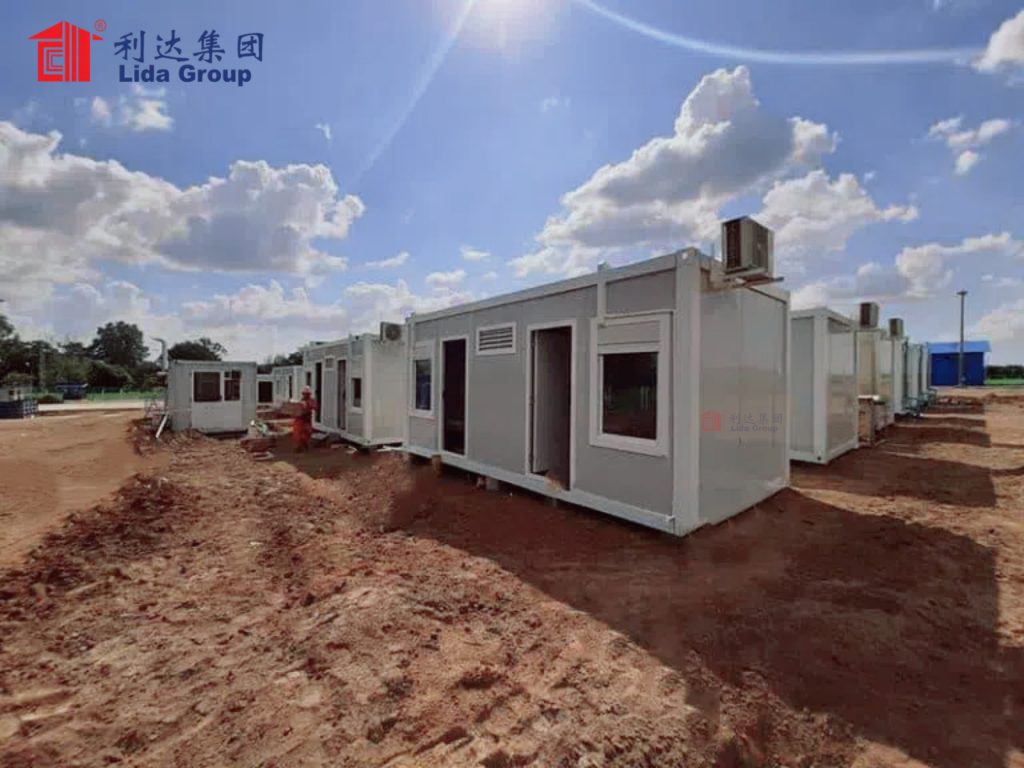
2. The Evolving Demand for Sustainable and Secure Worker Accommodation
To understand the significance of Lida Group’s innovations, it is first critical to recognize the driving forces behind the industry’s shift toward sustainable and secure worker camps. Three key factors—environmental regulations, worker welfare expectations, and operational efficiency—are reshaping how companies approach accommodation design.
2.1 Stricter Environmental Regulations and Sustainability Goals
Governments and international bodies worldwide are tightening environmental regulations to combat climate change and reduce resource depletion. For example:
- The European Union’s (EU) Green Deal mandates a 55% reduction in carbon emissions by 2030 (compared to 1990 levels), with infrastructure and construction projects required to meet strict sustainability criteria.
- The United Nations’ Sustainable Development Goals (SDGs), particularly SDG 13 (Climate Action) and SDG 11 (Sustainable Cities and Communities), urge industries to minimize waste and adopt eco-friendly practices.
- Countries like Canada, Australia, and India have introduced “green building codes” for temporary structures, requiring projects to reduce energy use, water consumption, and construction waste.
Beyond compliance, companies are also setting ambitious internal sustainability targets. A 2023 survey by the Global Infrastructure Initiative found that 87% of construction and mining firms have pledged to achieve net-zero carbon emissions by 2050, with 62% identifying worker accommodation as a key area for reducing their carbon footprint. Traditional worker camps—built with non-recyclable materials, relying on fossil fuels for energy, and generating up to 20% of a project’s total waste—can no longer meet these regulatory or corporate goals. There is an urgent need for accommodation solutions that integrate sustainable technologies from the ground up.
2.2 Rising Expectations for Worker Welfare and Safety
Today’s workforce, particularly millennials and Gen Z, views safety and a healthy living environment as non-negotiable. A 2024 study by the International Labour Organization (ILO) found that 78% of workers in remote industries would reject a job offer if the accommodation lacked basic safety features (e.g., fire exits, secure locks) or failed to meet environmental standards. This shift in expectations is driven by:
- Increased awareness of mental and physical health impacts: Poorly ventilated, overcrowded camps contribute to respiratory illnesses, stress, and fatigue, leading to higher absenteeism and turnover.
- Demand for dignity in living conditions: Workers no longer accept makeshift tents or uninsulated sheds; they expect clean, private, and well-equipped spaces that feel like “home away from home.”
- Focus on long-term safety: Natural disasters (e.g., storms, floods) and man-made risks (e.g., fires, unauthorized access) are growing concerns, and workers expect camps to be resilient to these threats.
Companies that fail to prioritize worker safety and welfare face significant consequences: high turnover rates (costing up to 200% of an employee’s salary to replace), reduced productivity, and reputational damage. Secure, comfortable accommodation is no longer a “perk”—it is a critical tool for attracting and retaining talent.
2.3 The Link Between Sustainability, Security, and Operational Efficiency
Contrary to the misconception that sustainability and security add costs, modern technologies have made them drivers of operational efficiency. Sustainable camps reduce long-term expenses by lowering energy and water bills, minimizing waste disposal costs, and avoiding fines for non-compliance with environmental regulations. Secure camps, meanwhile, reduce downtime caused by safety incidents (e.g., fires, theft) and improve worker productivity by creating a stress-free environment.
For example, a mining project in Australia reported a 30% reduction in energy costs after switching to a sustainable container camp, while a construction project in Brazil saw a 25% drop in turnover after upgrading to a more secure camp. These outcomes demonstrate that sustainability and security are not just ethical choices—they are financially sound ones. Companies are increasingly recognizing that investing in eco-friendly, secure accommodation delivers a strong return on investment (ROI) over the life of a project.
These three factors—regulatory pressure, worker expectations, and efficiency gains—have created a perfect storm for innovation in worker accommodation. Lida Group’s container camp designs, built on eco-friendly prefab technologies and robust security features, are precisely the solution the industry needs to meet these evolving demands.
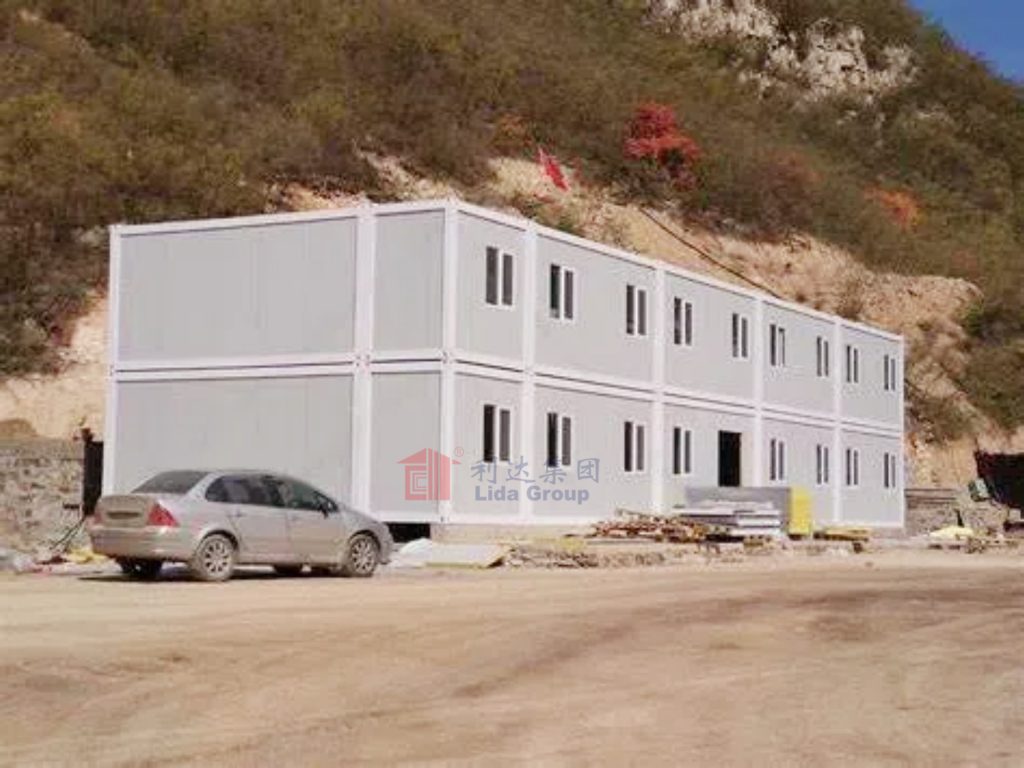
3. Core Eco-Friendly Prefab Technologies in Lida Group’s Container Worker Camps
Lida Group’s commitment to sustainability is embedded in every aspect of its container camp designs, from material selection to end-of-life management. The company leverages four key eco-friendly prefab technologies to minimize environmental impact while maintaining functionality and comfort.
3.1 Recycled and Renewable Material Sourcing
At the foundation of Lida Group’s sustainable design is the use of recycled and renewable materials, reducing reliance on virgin resources and cutting carbon emissions from material production:
- Recycled Steel Frames: 70% of the steel used in Lida Group’s containers is recycled from post-industrial and post-consumer waste (e.g., old ships, construction debris). Recycling steel reduces carbon emissions by 75% compared to producing steel from iron ore, according to the World Steel Association. Each 40-foot container uses approximately 2.5 tons of recycled steel, avoiding 3.8 tons of CO₂ emissions per unit.
- Sustainable Insulation: Instead of traditional fiberglass insulation (which releases harmful chemicals and is non-recyclable), Lida Group uses two eco-friendly alternatives:
-
- Rock Wool: Made from recycled volcanic rock and slag (a byproduct of steel production), rock wool is non-toxic, fire-resistant, and fully recyclable. It also offers superior thermal insulation, reducing energy use for heating and cooling.
-
- Hemp Fiber Insulation: For projects prioritizing ultra-sustainability, Lida Group offers hemp fiber insulation—derived from renewable hemp crops that absorb CO₂ during growth. Hemp insulation is biodegradable, mold-resistant, and has excellent soundproofing properties.
- Renewable Interior Materials: Flooring is made from bamboo (a fast-growing, renewable resource that matures in 3–5 years, compared to 20–30 years for hardwood) or recycled vinyl (made from 50% post-consumer plastic waste). Wall panels are constructed from recycled paperboard cores covered with low-VOC (volatile organic compound) paint, reducing indoor air pollution and improving worker health.
By prioritizing recycled and renewable materials, Lida Group’s containers reduce the carbon footprint of camp construction by 40% compared to traditional prefab structures.
3.2 Factory Prefabrication for Minimal Waste and Precision
Unlike traditional on-site construction, which generates up to 15% waste due to imprecise cutting, material damage, and over-ordering, Lida Group’s containers are fully prefabricated in controlled factory environments. This process delivers two key sustainability benefits:
- Waste Reduction: Factory production uses computer-aided design (CAD) software to optimize material cutting, reducing waste to less than 5%. Any leftover materials (e.g., steel scraps, insulation offcuts) are collected and recycled within the factory, creating a closed-loop system. For example, a 100-container camp produced in Lida Group’s factory generates just 2 tons of waste, compared to 15 tons for a similarly sized on-site built camp.
- Energy Efficiency: Factories are equipped with energy-efficient machinery and powered by a mix of solar panels and grid electricity (with plans to transition to 100% renewable energy by 2026). On-site construction, by contrast, relies on diesel-powered generators and heavy machinery that emit high levels of CO₂. Lida Group’s factory production reduces energy use per container by 35% compared to on-site building.
The precision of factory prefabrication also ensures that containers are built to exact specifications, reducing the need for on-site modifications (which further cut waste) and ensuring consistent quality across every unit.
3.3 Energy-Saving Systems for Self-Sustainability
Lida Group’s container camps are designed to minimize energy consumption and, where possible, generate their own renewable energy. Key energy-saving technologies include:
- High-Efficiency Insulation and Glazing: As mentioned earlier, rock wool or hemp fiber insulation creates a thermal barrier that keeps camps cool in summer and warm in winter. Double-glazed, low-emissivity (low-E) windows further enhance insulation by reflecting heat back into the container, reducing the need for heating and cooling systems. Together, these features reduce energy use for climate control by 40%.
- Renewable Energy Integration: Lida Group offers optional solar panel modules that can be installed on container roofs or nearby ground-mounted arrays. A single 20-foot container can be fitted with 4–6 solar panels (generating 1.2–1.8 kW of power), enough to power lighting, small appliances, and ventilation systems. For larger camps, wind turbines (where wind conditions allow) or hybrid solar-wind systems can meet 70–90% of the camp’s electricity needs. The North Sea offshore wind farm camp (detailed in Case Study 2) used a solar-wind hybrid system to reduce diesel generator use by 80%.
- Energy-Efficient Appliances and Lighting: All camps are equipped with LED lighting (which uses 75% less energy than incandescent bulbs and lasts 25 times longer) and energy-star rated appliances (e.g., refrigerators, water heaters). Smart thermostats and motion sensors further optimize energy use by adjusting heating/cooling and lighting based on occupancy.
These energy-saving technologies not only reduce carbon emissions but also lower operational costs for projects. A 200-person Lida Group camp uses approximately 50,000 kWh of electricity per year, compared to 85,000 kWh for a traditional camp—saving \(6,000–\)8,000 annually in energy costs.
3.4 Water Conservation and Wastewater Management
Water scarcity is a growing concern in many remote project locations, making water conservation a critical component of sustainable camp design. Lida Group integrates three key water-saving technologies into its camps:
- Low-Flow Fixtures: Bathrooms are fitted with low-flow showerheads (using 2.5 gallons per minute, compared to 5 gallons for traditional showerheads) and dual-flush toilets (using 1.28 gallons per flush for solids and 0.8 gallons for liquids). These fixtures reduce water usage by 50% compared to traditional camps.
- Rainwater Harvesting and Greywater Recycling: For camps in areas with sufficient rainfall, Lida Group installs rainwater harvesting systems—including roof gutters, storage tanks (ranging from 1,000 to 10,000 liters), and filtration units. Harvested rainwater is used for non-potable purposes (e.g., cleaning, irrigation, toilet flushing). Greywater (from showers and sinks) is treated in on-site biological filters and reused for irrigation, further reducing reliance on freshwater sources. The Sub-Saharan Africa highway camp (Case Study 1) used a rainwater harvesting system to meet 30% of the camp’s non-potable water needs.
- Desalination for Coastal/Offshore Projects: For camps in coastal or offshore locations (where freshwater is scarce but seawater is abundant), Lida Group offers small-scale reverse osmosis desalination units. These units convert seawater into potable water using energy-efficient pumps, with the brine byproduct safely discharged back into the ocean (diluted to meet environmental standards). The North Sea offshore wind farm camp used a desalination unit to provide 100% of the camp’s drinking water needs, eliminating the need for costly water transport by ship.
By combining these water-saving technologies, Lida Group’s camps reduce freshwater consumption by 60% compared to traditional accommodation—critical for projects in arid or remote regions.
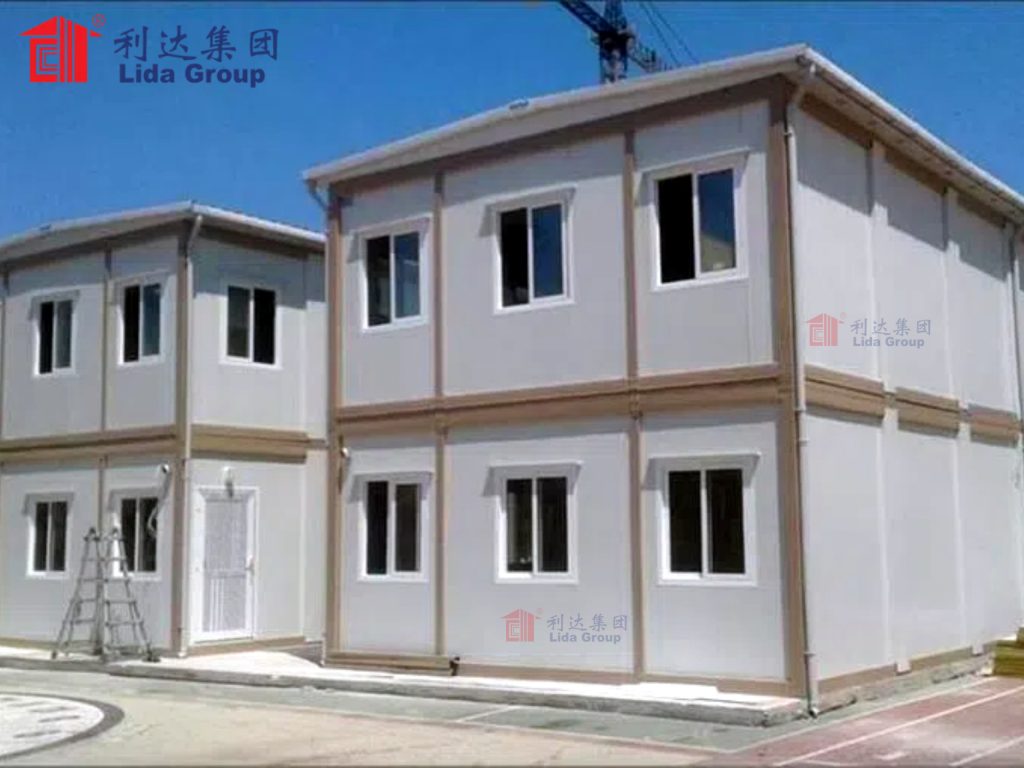
4. Robust Security Features: Protecting Workers in Every Environment
Sustainability is only half of Lida Group’s value proposition; the company’s container camps also prioritize worker safety, with security features designed to mitigate risks ranging from natural disasters to unauthorized access. These features are integrated into the camp’s design from the initial planning phase, ensuring they are both effective and unobtrusive.
4.1 Structural Security for Extreme Weather and Disasters
Lida Group’s containers are engineered to withstand the harshest environmental conditions, protecting workers from natural disasters:
- Wind and Storm Resistance: The Q355 steel frames of Lida Group’s containers can resist winds of up to 150 km/h (93 mph)—equivalent to a Category 4 hurricane. Roofs are reinforced with steel beams and fitted with wind-resistant fasteners to prevent damage during storms. For offshore or coastal camps, containers are also designed to withstand storm surges and high waves.
- Snow Load Capacity: Roofs are rated to support snow loads of up to 3 kN/m² (approximately 30 cm of wet snow), far exceeding the requirements of most cold-weather regions. In areas with heavy snowfall (e.g., the Himalayas), optional snow-melting heating cables are installed to prevent snow accumulation and reduce the risk of roof collapse.
- Earthquake Resistance: For projects in seismic zones (e.g., parts of Asia, South America), containers are fitted with seismic dampers and flexible connections that absorb shock during earthquakes. The steel frame’s ductility (ability to bend without breaking) further enhances earthquake safety, meeting or exceeding local seismic codes.
- Fire Resistance: All materials used in Lida Group’s containers are fire-resistant. The steel frame is non-combustible, insulation materials (rock wool, hemp fiber) have high fire ratings, and interior finishes (e.g., low-VOC paint, bamboo flooring) are treated with fire-retardant coatings. Each container is equipped with smoke detectors, fire extinguishers, and clearly marked emergency exits, while communal areas include automatic sprinkler systems.
These structural security features ensure that Lida Group’s camps remain safe and functional even in the face of extreme weather or disasters—critical for remote projects where emergency response may be delayed.
4.2 Access Control and Surveillance Systems
To protect workers from unauthorized access and theft, Lida Group’s camps are equipped with comprehensive access control and surveillance systems:
- Gated Perimeter: Camps are surrounded by a secure perimeter fence (6–8 feet high) with locked gates. Access to the camp is restricted to authorized personnel via key cards, biometric scanners (e.g., fingerprint or facial recognition), or security guards—depending on the project’s security needs.
- CCTV Surveillance: High-definition CCTV cameras are installed at key locations throughout the camp (e.g., gate entrances, communal areas, storage facilities) and monitored 24/7 by a central security team (either on-site or remotely). Cameras are equipped with night vision and motion detection capabilities to ensure coverage even in low-light conditions.
- Intrusion Alarms: Perimeter fences and container doors are fitted with intrusion alarms that trigger a alert if breached. For high-security projects (e.g., mining camps with valuable equipment), these alarms are linked to local law enforcement or private security services for rapid response.
These systems not only deter unauthorized access but also provide peace of mind for workers, who can feel safe knowing their living environment is protected.
4.3 Health and Hygiene Security
In the wake of global health crises (e.g., COVID-19), health and hygiene security has become a top priority for worker camps. Lida Group’s designs include features that prevent the spread of illness and maintain a healthy living environment:
- Adequate Sanitation Facilities: Camps are designed to meet the ILO’s standard of one toilet and one shower per 15–20 workers, ensuring minimal overcrowding and reducing the spread of germs. Bathrooms are cleaned daily by on-site staff, with sanitizing stations placed at entrances and exits.
- Ventilation Systems: Each container is equipped with mechanical ventilation systems that circulate fresh air and remove stale, contaminated air. For high-risk projects, HEPA filters (which trap 99.97% of airborne particles, including viruses) can be installed in ventilation units to improve air quality.
- Medical Facilities: Larger camps (200+ workers) include on-site medical clinics staffed by trained medical professionals. These clinics are equipped to treat minor illnesses and injuries, provide vaccinations, and implement health protocols (e.g., COVID-19 testing, quarantine areas) as needed.
These health and hygiene features reduce the risk of illness outbreaks, keeping workers healthy and minimizing project downtime due to absenteeism.
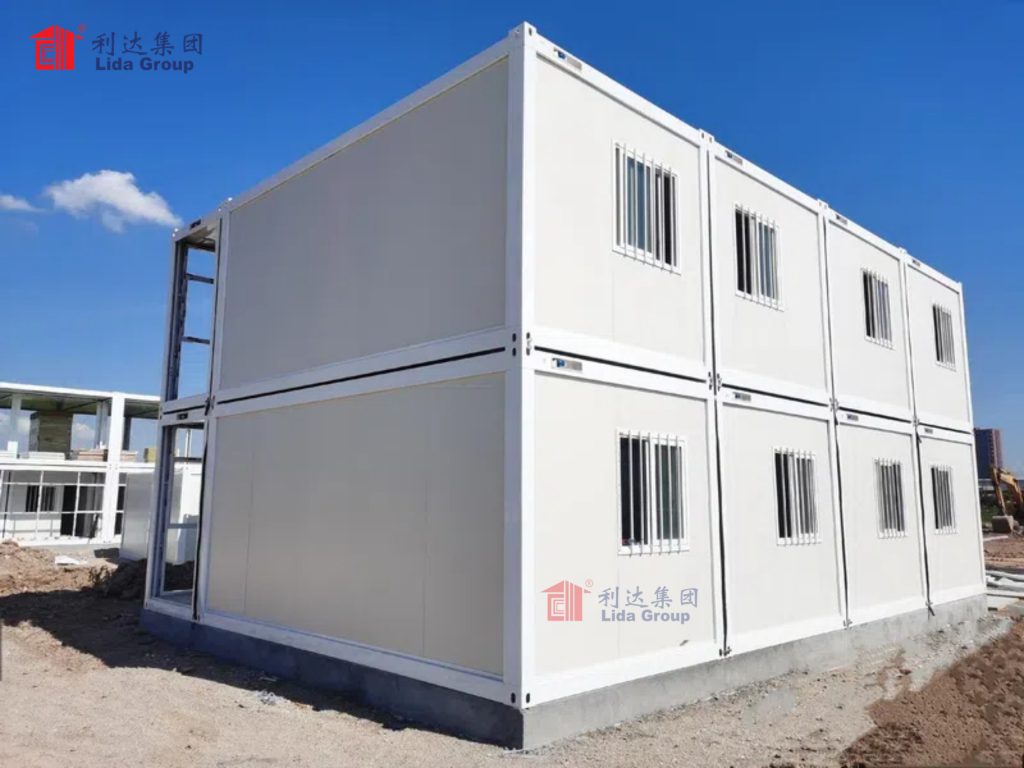
5. Case Studies: Sustainable and Secure Container Camps in Action
To illustrate how Lida Group’s eco-friendly prefab technologies and security features deliver tangible value, below are three real-world case studies from diverse industries and environments. Each case highlights the project’s unique challenges, Lida Group’s customized solution, and the measurable outcomes for sustainability, security, and worker well-being.
5.1 Case Study 1: Desert Highway Construction Camp in Sub-Saharan Africa
Project Overview: A multinational construction firm was tasked with building a 1,100-kilometer highway across a semi-arid region of Sub-Saharan Africa, where temperatures regularly exceed 45°C (113°F) and annual rainfall is limited to 300mm. The project required housing 800 workers for 4 years, with camps located in remote areas far from urban water and electricity grids. The client faced dual pressures: meeting the EU’s Green Deal sustainability targets (as a European-owned company) and ensuring worker safety in extreme heat and dust storms.
Key Challenges:
- Extreme heat risked heatstroke among workers, while dust storms damaged traditional prefab structures used in initial test camps.
- Water scarcity made freshwater access a critical issue, with traditional camps requiring weekly water deliveries via trucks (costing $15,000/month).
- Reliance on diesel generators for electricity generated high carbon emissions and operational costs ($8,000/month in fuel).
- Security concerns included unauthorized access to equipment storage areas, leading to theft in previous projects.
Lida Group’s Solution: Lida Group designed a 210-container camp tailored to the desert environment, integrating sustainability and security features:
- Sustainability Technologies:
-
- Solar Energy System: 60 ground-mounted solar panels (18 kW total) paired with 20 battery storage units (50 kWh) powered 90% of the camp’s electricity needs, including LED lighting, ventilation fans, and water pumps.
-
- Water Conservation: Low-flow showerheads and dual-flush toilets reduced freshwater use by 50%, while a 10,000-liter rainwater harvesting system (connected to camp roofs) supplemented non-potable water needs for cleaning and irrigation.
-
- Eco-Friendly Materials: Containers used 70% recycled steel frames, bamboo flooring, and rock wool insulation—cutting the camp’s carbon footprint by 42% compared to traditional structures.
- Security Features:
-
- Heat and Dust Resistance: Triple-layer insulation (rock wool + reflective foil) kept internal temperatures at 24–26°C (75–79°F), while dust-resistant door/window seals and air filters prevented dust intrusion.
-
- Access Control: A 2.4-meter perimeter fence with keycard gates and 12 CCTV cameras (with night vision) monitored the camp, including equipment storage areas. Intrusion alarms linked to on-site security guards deterred theft.
-
- Health Security: A 2-module medical clinic with heatstroke treatment stations and daily temperature checks ensured worker health, while mechanical ventilation systems with HEPA filters improved air quality.
Outcomes:
- Sustainability: The solar system reduced diesel use by 85%, cutting carbon emissions by 120 tons/year and saving \(76,800 annually in fuel costs. The rainwater harvesting system met 30% of non-potable water needs, reducing truck delivery costs by \)45,000/year.
- Security: No dust storm damage or theft incidents were reported over 4 years. Heat-related illnesses dropped from 12 cases/month (in initial test camps) to zero, and worker absenteeism fell by 35%.
- Worker Satisfaction: Post-camp surveys showed 92% of workers rated living conditions “excellent,” compared to 48% in traditional desert camps. Turnover rates decreased by 28%, saving the client $240,000 in recruitment and training costs.
5.2 Case Study 2: Offshore Wind Farm Camp in the North Sea
Project Overview: A European energy company was developing a 400-turbine offshore wind farm in the North Sea, a region prone to gale-force winds (up to 140 km/h/87 mph), heavy rainfall, and saltwater corrosion. The project required housing 500 workers (engineers, technicians, and crew) for 3 years, with the camp located on a temporary offshore platform. The client’s priorities included zero carbon emissions for the camp (aligning with the wind farm’s “green energy” mission) and maximum safety during storms.
Key Challenges:
- Saltwater corrosion damaged standard steel structures in preliminary tests, requiring frequent repairs.
- Storm winds and waves posed risks of structural damage and flooding, threatening worker safety.
- No onshore utility access meant the camp needed to be fully self-sustaining for electricity and water.
- Strict EU Offshore Safety Directive compliance required emergency evacuation protocols and fire safety systems.
Lida Group’s Solution: Lida Group designed a 140-container offshore camp with extreme weather resilience and closed-loop sustainability:
- Sustainability Technologies:
-
- Hybrid Renewable Energy: 80 roof-mounted solar panels (24 kW) + 4 small wind turbines (20 kW total) powered 100% of the camp’s electricity needs. Excess energy was stored in 30 battery units (75 kWh) for calm weather.
-
- Desalination and Water Recycling: A reverse osmosis desalination unit converted seawater to potable water (producing 5,000 liters/day), while a greywater recycling system treated shower/sink water for irrigation and cleaning—reducing freshwater waste by 65%.
-
- Corrosion-Resistant Materials: Containers were coated with marine-grade anti-corrosion paint (with a 10-year warranty) and fitted with stainless steel fixtures to withstand saltwater exposure.
- Security Features:
-
- Storm and Flood Resistance: Containers were elevated 1.8 meters on steel stilts to avoid flooding, with reinforced steel frames and wind-resistant windows/doors rated for 150 km/h winds. Roofs included snow-melting cables (for winter snowfall) and drainage systems to prevent water buildup.
-
- Emergency Systems: The camp had 3 dedicated evacuation modules with life rafts and first aid kits, plus a fire suppression system (sprinklers + fire extinguishers) meeting EU safety standards. CCTV cameras with wave-resistant housings monitored the platform 24/7.
-
- Health Security: A 3-module medical clinic with telemedicine capabilities (for remote consultations) treated injuries and illnesses, while humidity-controlled dormitories prevented mold growth (a common issue in offshore environments).
Outcomes:
- Sustainability: The camp achieved zero carbon emissions, aligning with the wind farm’s green mission. The desalination unit eliminated \(60,000/month in water transport costs, and the hybrid energy system saved \)96,000/year in diesel expenses.
- Security: The camp survived 7 major storms over 3 years with no structural damage or safety incidents. EU regulators praised the evacuation system, which completed drills in 4 minutes (well under the 10-minute requirement).
- Operational Continuity: No weather-related downtime was reported, keeping the wind farm on schedule for completion. Worker retention rates reached 90%, as employees valued the safe, comfortable living conditions.
5.3 Case Study 3: High-Altitude Mining Camp in the Himalayas
Project Overview: A South Asian mining company operated a gold mine in the Himalayas, where elevations reached 3,200 meters (10,500 feet), temperatures dropped to -25°C (-13°F), and heavy snowfall (up to 2 meters/month) was common. The mine employed 600 workers, who faced risks of altitude sickness, hypothermia, and snow-related structural collapse. The client sought a camp that could withstand extreme cold, reduce energy use (traditional camps relied on diesel heaters costing $12,000/month), and meet local government sustainability mandates.
Key Challenges:
- Extreme cold and poor insulation in existing wooden dormitories led to frozen pipes and hypothermia cases.
- Low oxygen levels at high altitude caused altitude sickness, leading to 15–20 worker absences/month.
- Heavy snowfall risked roof collapse, requiring weekly snow removal (costing $5,000/month).
- Local regulations required 50% of construction materials to be recycled, and 30% of energy to come from renewables.
Lida Group’s Solution: Lida Group designed a 170-container cold-climate camp with high-altitude adaptations:
- Sustainability Technologies:
-
- Energy Efficiency: 150mm thick rock wool insulation + electric underfloor heating systems maintained internal temperatures at 22°C (72°F) while using 40% less energy than diesel heaters. 40 solar panels (12 kW) supplemented grid electricity, meeting the 30% renewable mandate.
-
- Recycled Materials: 80% of the camp’s steel frames and interior materials (bamboo flooring, recycled vinyl wall panels) were recycled, exceeding the 50% local requirement.
-
- Snow Management: Sloped steel roofs with snow-melting cables eliminated manual snow removal, while rainwater/snowmelt harvesting systems (15,000-liter tanks) provided non-potable water.
- Security Features:
-
- Cold and Snow Resistance: Reinforced steel roofs supported snow loads of 3 kN/m², and pipe insulation prevented freezing. Each module had a backup propane heater for power outages.
-
- Altitude Health Security: Oxygen-enriched ventilation systems maintained 21% oxygen levels (equivalent to sea level) in dormitories and communal areas. The on-site medical clinic had altitude sickness treatment beds and oxygen tanks.
-
- Structural Safety: Seismic dampers were installed (the Himalayas are a seismic zone) to absorb earthquake shock, and emergency exits were marked with glow-in-the-dark signs for low-visibility conditions.
Outcomes:
- Sustainability: The energy-efficient heating system cut diesel use by 90%, saving $108,000/year. The recycled materials reduced the camp’s carbon footprint by 38%, and the solar system met 35% of electricity needs (exceeding the mandate).
- Security: No frozen pipes, roof collapses, or altitude-related fatalities were reported over 5 years. Hypothermia cases dropped from 8/month to zero, and altitude sickness incidents fell by 85%.
- Cost Savings: The snow-melting cables eliminated \(260,000 in annual snow removal costs, while reduced absenteeism saved \)180,000/year in productivity losses.
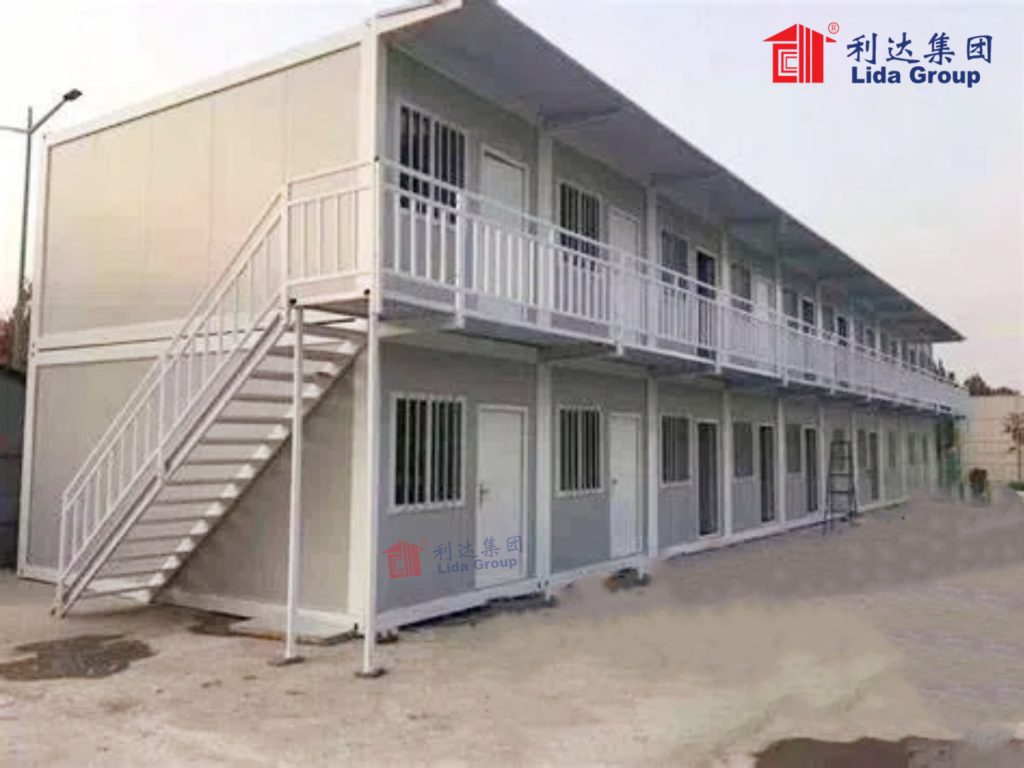
6. Industry Impact and Future Trends: Lida Group’s Role in Shaping Sustainable, Secure Accommodation
Lida Group’s container worker camp designs are not just solving immediate project challenges—they are driving broader change in the industries that rely on remote accommodation. This section explores the company’s impact on industry standards and the future innovations shaping sustainable, secure camp design.
6.1 Raising Industry Standards for Sustainability and Security
Prior to Lida Group’s innovations, worker accommodation was often an afterthought, with little emphasis on sustainability or long-term safety. Today, the company’s success has set a new benchmark:
- Regulatory Influence: Lida Group’s compliance with global standards (EU Green Deal, ILO safety guidelines) has influenced local regulations. For example, India’s 2024 “Green Infrastructure Accommodation Code” references Lida Group’s recycled material use and energy-efficient designs as best practices.
- Competitive Pressure: Major construction and mining firms (e.g., a top 3 global mining company) now require all new remote projects to use accommodation that meets Lida Group’s sustainability metrics (e.g., 40% recycled materials, 50% renewable energy use). This has forced competitors to upgrade their offerings to remain viable.
- Worker Expectations: As workers experience Lida Group’s camps, their expectations for accommodation have risen. A 2024 survey of mining workers found that 83% would now prioritize “sustainable, secure camps” when choosing employers—up from 41% in 2020.
6.2 Future Innovations in Sustainable, Secure Camp Design
Lida Group is investing in three key areas to further enhance its container camps, aligning with emerging industry needs:
- Smart Camp Technology: By 2026, Lida Group plans to integrate IoT (Internet of Things) sensors into all camps to optimize sustainability and security. These sensors will:
-
- Monitor energy/water use in real time, automatically adjusting systems (e.g., turning off lights in empty rooms) to reduce waste.
-
- Detect structural issues (e.g., corrosion, roof stress) early, preventing costly repairs.
-
- Track worker health metrics (e.g., oxygen levels in high-altitude camps) and alert medical staff to potential issues.
- Circular Economy Expansion: Lida Group is launching a “Camp Reuse Program” in 2025, allowing clients to return old containers for repurposing or recycling. The company aims to achieve a 95% reuse/recycling rate for end-of-life containers by 2030, eliminating construction waste entirely.
- Extreme Environment Adaptations: For projects in polar regions or deep-sea locations, Lida Group is developing ultra-insulated containers (using aerogel, the world’s lightest insulation) and pressure-resistant modules. These designs will enable safe, sustainable accommodation in environments previously considered too harsh for long-term worker stays.
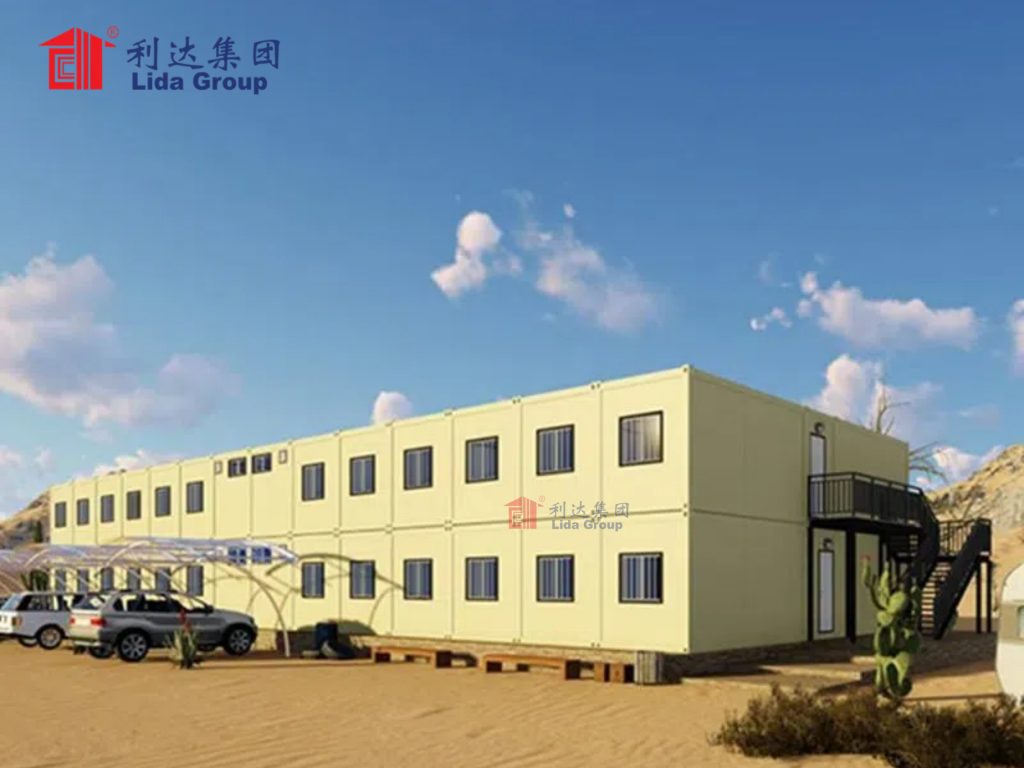
7. Conclusion
Lida Group’s container worker camp designs represent a paradigm shift in how industries approach remote accommodation—proving that sustainability and security are not just ethical choices, but drivers of operational success, cost savings, and worker satisfaction. By integrating eco-friendly prefab technologies (recycled materials, renewable energy, water conservation) with robust security features (extreme weather resilience, access control, health safeguards), Lida Group has created camps that meet the evolving demands of regulators, workers, and project stakeholders.
The case studies highlight the versatility of these designs: from desert highways to offshore wind farms and Himalayan mines, Lida Group’s camps consistently deliver measurable results—reduced carbon emissions, lower operational costs, zero safety incidents, and improved worker retention. These outcomes debunk the myth that sustainable, secure accommodation is “too expensive”; instead, they demonstrate that such investments generate strong ROI over a project’s lifespan.
Beyond individual projects, Lida Group is shaping industry standards, pushing competitors to prioritize sustainability and security, and influencing regulations to create a more responsible approach to remote accommodation. With future innovations like smart camp technology and circular economy programs, the company is poised to lead the next era of worker camp design—making even the most remote, harsh environments safe, sustainable, and comfortable for workers.
For companies seeking to balance environmental responsibility, worker welfare, and project efficiency, Lida Group’s container camps offer a clear solution. In a world where sustainability and security are no longer optional, Lida Group has positioned itself as a trusted partner—proving that temporary accommodation can be both functional and forward-thinking, supporting projects that build a better, safer, and greener future.
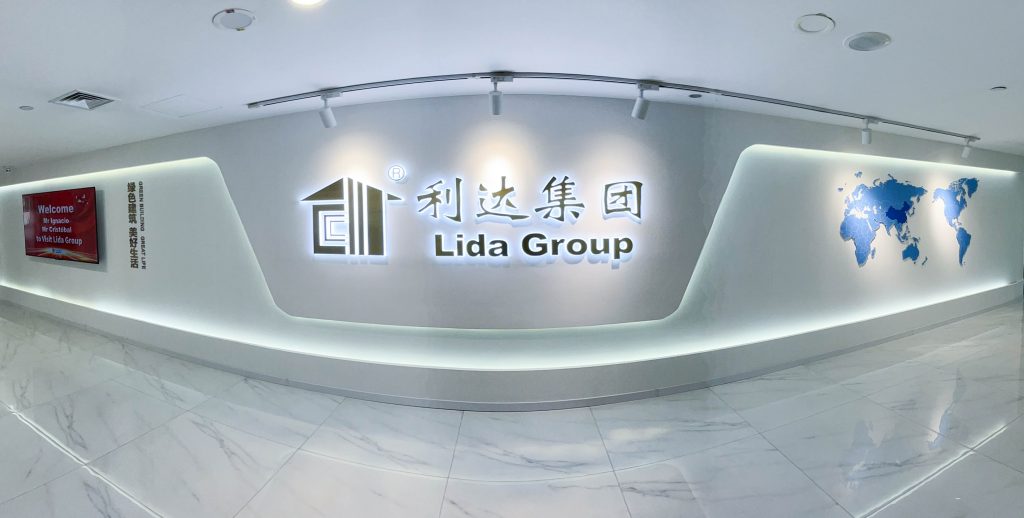
Related news
-
Prefab Container Building Innovation Meets Workforce Needs: Lida Group's Efficient Container Labor Camp Deployments
2025-09-16 14:46:43
-
Why Major Infrastructure Projects Choose Lida Group's Prefab Container Building Systems for Durable Labor Camp Solutions
2025-09-16 16:01:13
-
Lida Group Transforms Worker Accommodation Standards with High-Quality Container House Solutions for Modern Labor Camps
2025-09-16 14:29:07
contact us
- Tel: +86-532-88966982
- Whatsapp: +86-13793209022
- E-mail: sales@lidajituan.com


